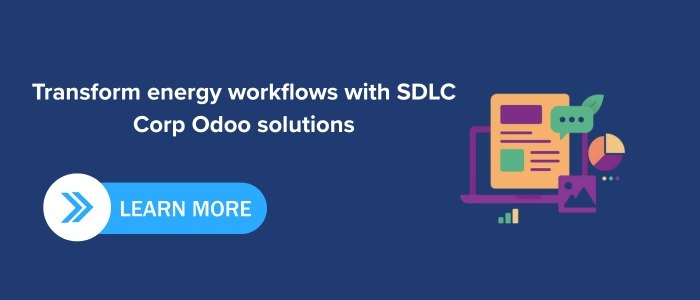Introduction
Odoo for energy and utilities provides a unified system to manage assets, field operations, billing, and compliance within one platform. Energy companies operate across wide geographic areas and depend on accurate coordination between equipment, technicians, customer records, and regulatory processes. When these workflows rely on disconnected tools, delays increase and data accuracy suffers. Odoo addresses these challenges by offering real time visibility, structured workflows, and consistent data across departments.
1. Challenges in Energy and Utilities
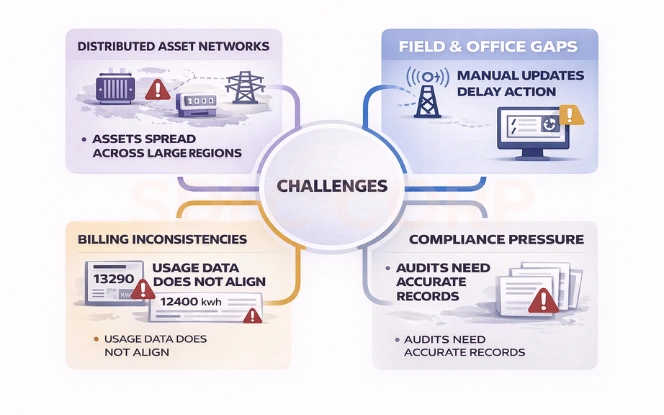
Energy and utility companies face operational complexity on multiple fronts. Infrastructure scale, regulatory pressure, and service reliability all demand strong systems.
Key challenges include:
- Large and distributed asset networks
Transformers, meters, transmission lines, turbines, and substations are spread across regions. Without centralized tracking, teams struggle to monitor asset health and plan maintenance effectively.
- Limited coordination between field and office teams
Field technicians often rely on manual updates, which delays reporting and decision making. This affects outage response times and increases operational risk.
- Billing inconsistencies and customer disputes
Meter readings, usage data, and customer records often sit in different systems. When these do not align, billing errors occur and customer trust weakens.
- Strict compliance and audit requirements
Energy providers must maintain detailed inspection logs, safety records, and environmental reports. Missing or inconsistent data creates audit challenges.
- Manual reporting and poor visibility
Without real time dashboards, leaders lack clear insight into outages, downtime, asset performance, and service efficiency.
Odoo reduces these issues by consolidating operational data into one structured system.
2. How Odoo Helps the Energy Sector
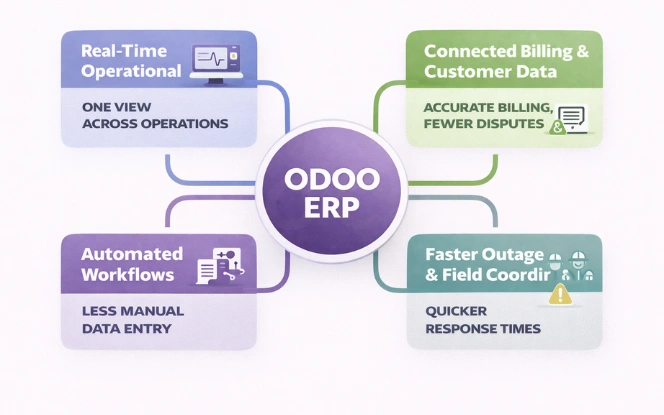
Odoo connects operational teams and ensures information flows without delays.
Odoo supports energy companies by:
- Providing real time visibility into operations
Managers can monitor asset condition, maintenance progress, field activities, and inventory levels from one view. This allows faster decisions when issues arise and reduces reliance on delayed manual reports.
- Aligning customer data with billing and service workflows
Customer records, usage data, and invoices remain connected throughout the billing cycle. This alignment reduces disputes and helps support teams respond with accurate information.
- Reducing manual data entry
Automation removes repetitive tasks such as duplicate updates across systems. As a result, teams spend less time correcting errors and more time managing operations.
- Supporting compliance with organized records
Inspection results, service logs, and approvals remain stored and searchable in one place. This simplifies audits and improves accountability.
- Improving coordination during outages and emergencies
Live updates from field teams allow control centers to allocate resources quickly. This improves restoration times and limits service disruption.
Companies planning long term system improvements often review How odoo erp drives digital transformation in energy utilities to understand how Odoo supports modernization.
3. Key Odoo Modules for Energy Teams
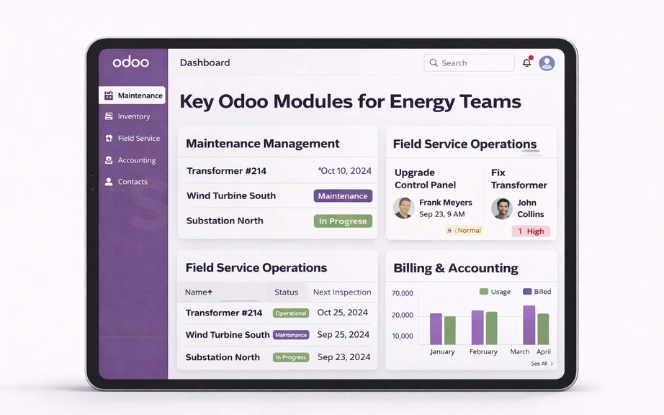
Odoo includes core modules that work together to support energy operations at scale.
- Maintenance management
Enables preventive and corrective maintenance planning for assets such as transformers, turbines, meters, and substations. Service history, inspection results, and upcoming schedules stay documented, which reduces unplanned downtime.
- Inventory and spare parts control
Tracks tools and critical components across warehouses, depots, and field vehicles. Accurate stock visibility ensures technicians have required parts available and reduces emergency procurement costs.
- Field service operations
Supports task assignment, route planning, and real time updates from technicians. Field teams can capture photos, readings, and service notes on site, improving record accuracy.
- Billing and accounting workflows
Manages usage based billing, invoices, and payments in one system. Alignment with meter data helps reduce disputes and improves financial clarity.
- Customer and service record management
Keeps customer details, service history, billing activity, and communication logs connected, which supports consistent service delivery.
4. Smart Grid and IoT Support
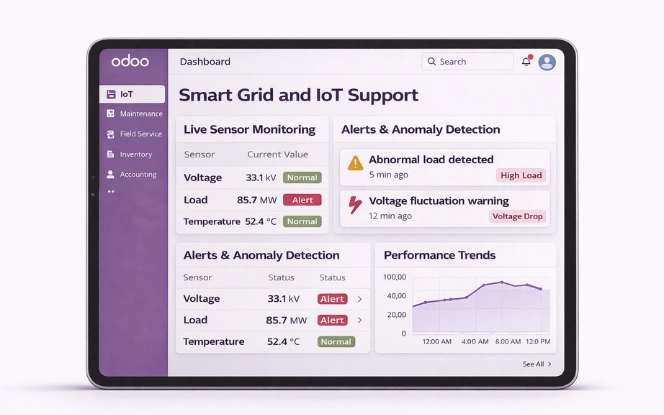
Modern energy networks rely on connected devices and real time data.
Odoo supports smart grid operations by:
- Monitoring sensor data such as load, voltage, and temperature
These readings help teams understand network conditions as they change. Early visibility allows operators to detect stress points before failures occur.
- Triggering alerts for abnormal conditions
When sensors report unusual values, alerts notify teams immediately. This supports faster investigation and prevents minor issues from escalating.
- Providing performance dashboards
Dashboards convert raw sensor data into clear trends and indicators. Managers can track network stability and plan maintenance based on actual usage patterns.
- Automating meter readings
Automatic data capture removes manual entry delays. This improves billing accuracy and ensures usage data remains current.
The Odoo energy management module further enhances visibility into usage patterns and network performance.
5. Managing Renewable Energy Workflows
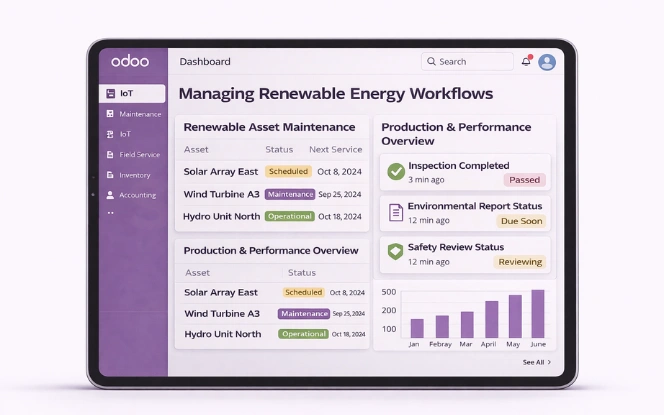
Renewable energy operations require structured monitoring and long term performance tracking.
Odoo supports renewable systems by:
- Scheduling maintenance for solar panels, inverters, and tracking systems
Regular service schedules help maintain output efficiency and reduce unexpected performance drops.
- Recording wind turbine inspection and service data
Inspection history and maintenance actions remain visible over long cycles. This supports safety reviews and long term reliability.
- Tracking hydro plant operational metrics
Flow rates, pressure, and temperature readings are stored centrally. Teams can review trends to ensure stable operation.
- Managing environmental and compliance reports
Environmental data and regulatory documentation remain organized. This simplifies reporting for renewable facilities.
- Analyzing production trends
Historical output data helps teams plan capacity upgrades and evaluate equipment performance.
These workflows strengthen energy asset tracking and maintenance ERP processes across renewable installations.
6. Field Service and Mobile Teams
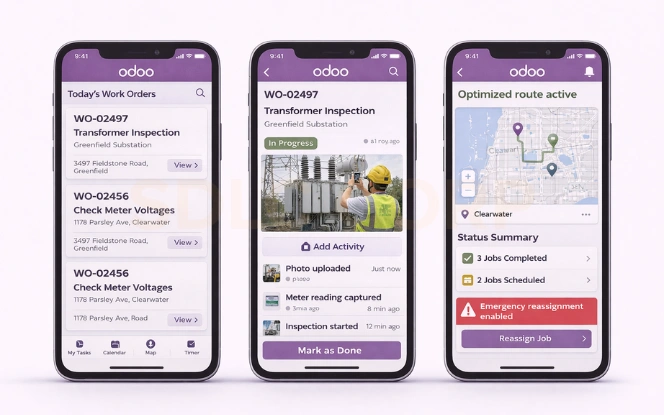
Field teams are critical to daily energy operations.
Odoo supports field service by:
- Delivering clear task instructions to mobile devices
Technicians receive complete job details, asset history, and safety notes before arriving on site. This reduces rework and improves safety.
- Capturing real time updates from the field
Photos, readings, and notes are uploaded immediately. Office teams gain visibility without waiting for manual reports.
- Optimizing route planning
Efficient routing reduces travel time and fuel cost. Technicians can complete more tasks per shift.
- Supporting emergency task reassignment
During outages or failures, managers can quickly reassign work. This improves response time and service continuity.
These capabilities strengthen utility operations management software practices and improve service reliability.
7. Compliance and Reporting Needs
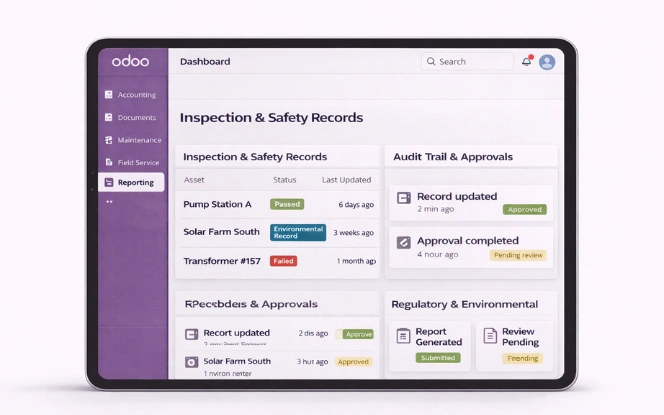
Energy companies must maintain accurate records for safety, regulatory, and audit purposes.
Odoo simplifies compliance by:
- Centralizing inspection logs and safety documents
All records stay linked to specific assets or activities. Teams can retrieve information quickly during audits.
- Maintaining time stamped audit trails
Every update includes a clear history of changes. This improves transparency and accountability.
- Generating operational and environmental reports
Leaders can review outage trends, downtime levels, emissions data, and maintenance activity. This supports informed planning.
- Supporting approval workflows
Sensitive actions pass through defined review steps. This reduces risk and ensures policy adherence.
This centralized approach reduces compliance risk and saves time during audits.
8. Why SDLC Corp Is the Right Odoo Partner
SDLC Corp helps energy and utility companies design and implement Odoo systems that reflect real operational needs.
Our approach includes:
- Building workflows aligned with field conditions and asset structures.
- Integrating meters, devices, and external systems.
- Delivering scalable configurations that support growth.
- Providing long term technical guidance and system support.
Organizations needing tailored functionality can explore Odoo customization services to shape workflows around their operational needs. Our focus remains on clarity, stability, and long term system performance.
Conclusion
Odoo for energy and utilities brings asset management, field operations, billing, and compliance into one structured system. It reduces manual work, improves data accuracy, and supports better coordination across teams. With real time visibility and organized workflows, energy companies gain stronger operational control.
For organizations planning system improvements or operational alignment, starting the discussion early helps define the right structure. You can contact us to explore how Odoo can support your energy operations.
FAQs
How does Odoo support energy and utilities operations?
Odoo supports energy and utilities by managing assets, maintenance, field service, billing, inventory, and compliance in one system.
Can Odoo handle asset maintenance for large energy networks?
Yes. Odoo tracks asset condition, service history, and maintenance schedules across large and distributed energy networks.
Is Odoo suitable for renewable energy companies?
Odoo works well for renewable energy operations such as solar, wind, and hydro. It helps manage equipment maintenance, performance tracking, environmental reporting, and production analysis.
How does Odoo improve field service management in utilities?
Odoo provides mobile access for field teams, task scheduling, route planning, and real time updates.
Can Odoo help energy companies meet compliance and reporting requirements?
Yes. Odoo centralizes inspection records, safety documents, maintenance logs, and audit trails.

